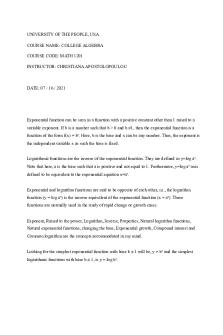Unit 4 Exponential and Logarithmic Functions in Economics PDF

| Title | Unit 4 Exponential and Logarithmic Functions in Economics |
|---|---|
| Course | Economics 2A |
| Institution | University of Johannesburg |
| Pages | 2 |
| File Size | 89.4 KB |
| File Type | |
| Total Downloads | 17 |
| Total Views | 135 |
Summary
lecture notes...
Description
Unit 4: Exponential and Logarithmic Functions in Economics Effective vs. Nominal Rates of Interest What is the nominal interest rate (𝑖 )? o Nominal interest rates can be compounded in various ways (e.g. annually, semi-annually, quarterly, monthly, daily, continuously)
What is the effective interest rate (𝑖𝑒 )? o Effective interest rates compute the total interest rate earned over a period when there is interest compounding (1 + 𝑖𝑒 ) Example: If 𝑷𝑽 savings earn a 𝒊 nominal interest rate per annum compounded 𝒏 times, what is effective interest rate (𝒊𝒆 ) earned on 𝑷𝑽 savings over the period of one year? 𝒊
Solution: 𝑷𝑽(𝟏 + 𝒊𝒆 ) = 𝑷𝑽(𝟏 + 𝒏)𝒏(𝟏) 𝒊
𝒊𝒆 = (𝟏 + 𝒏)𝒏 − 𝟏 What happens to the value of 𝒓𝒆 when 𝒏 → ∞?
Discounting Time value of money =>A sum of money received in the future is worth less than the same sum of money received today (Why?) Discounting is the process of determining the present value (𝑷𝑽) of a future some of money (𝑭𝑽)
Example: If you want to receive amount 𝑭𝑽 in 𝒕 years at an interest rate of 𝒊 per annum compounded annually, much should you invest today? Solution: Find the present value (𝑷𝑽) of the investment 𝑭𝑽 = 𝑷𝑽(𝟏 + 𝒊)𝒕 𝑷𝑽 = 𝑭𝑽(𝟏 + 𝒊)−𝒕
Converting Exponential to Natural Exponential Functions Example: Show how the equivalent continuously 𝒊
compounded growth rate (𝒓) for 𝑷𝑽(𝟏 + )𝒏𝒕 is 𝒏
given by 𝒏𝒍𝒏(𝟏 + Solution:
𝒊 ) 𝒏...
Similar Free PDFs

4.1 Exponential Functions
- 2 Pages

Exponential Functions Lesson
- 25 Pages

Exponential Functions Quiz 12
- 1 Pages
Popular Institutions
- Tinajero National High School - Annex
- Politeknik Caltex Riau
- Yokohama City University
- SGT University
- University of Al-Qadisiyah
- Divine Word College of Vigan
- Techniek College Rotterdam
- Universidade de Santiago
- Universiti Teknologi MARA Cawangan Johor Kampus Pasir Gudang
- Poltekkes Kemenkes Yogyakarta
- Baguio City National High School
- Colegio san marcos
- preparatoria uno
- Centro de Bachillerato Tecnológico Industrial y de Servicios No. 107
- Dalian Maritime University
- Quang Trung Secondary School
- Colegio Tecnológico en Informática
- Corporación Regional de Educación Superior
- Grupo CEDVA
- Dar Al Uloom University
- Centro de Estudios Preuniversitarios de la Universidad Nacional de Ingeniería
- 上智大学
- Aakash International School, Nuna Majara
- San Felipe Neri Catholic School
- Kang Chiao International School - New Taipei City
- Misamis Occidental National High School
- Institución Educativa Escuela Normal Juan Ladrilleros
- Kolehiyo ng Pantukan
- Batanes State College
- Instituto Continental
- Sekolah Menengah Kejuruan Kesehatan Kaltara (Tarakan)
- Colegio de La Inmaculada Concepcion - Cebu




![Solutions 6.4 [Logarithmic Functions ]](https://pdfedu.com/img/crop/172x258/1o20d9djyrn0.jpg)



![Solutions 6.3 [Exponential Functions ]](https://pdfedu.com/img/crop/172x258/lyrod5d8x3n7.jpg)



